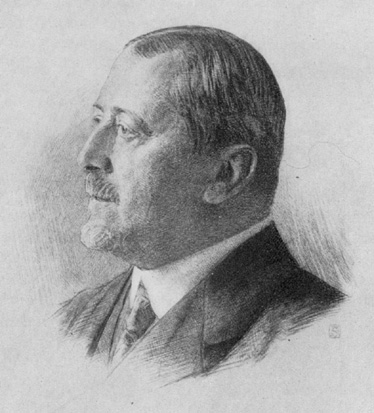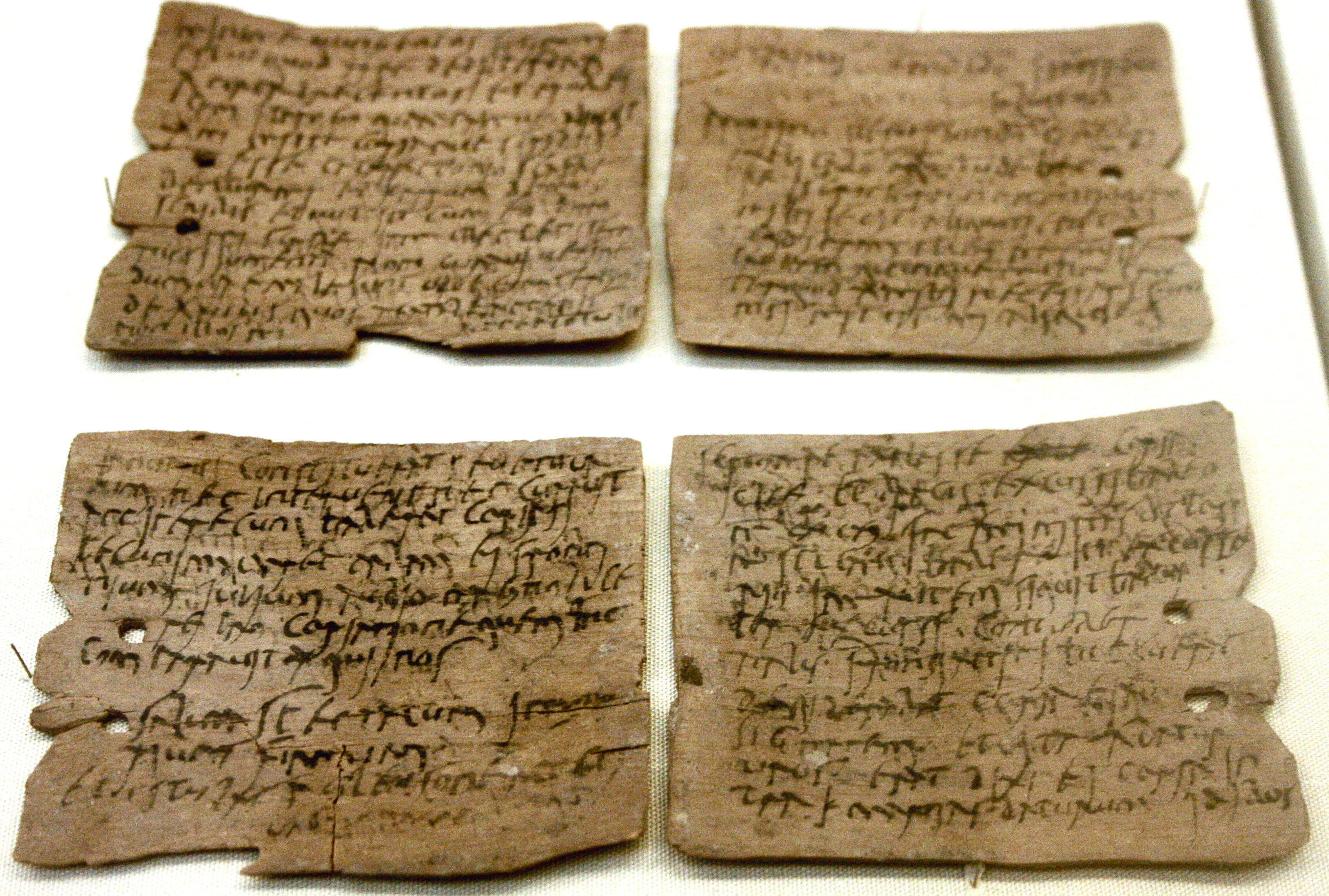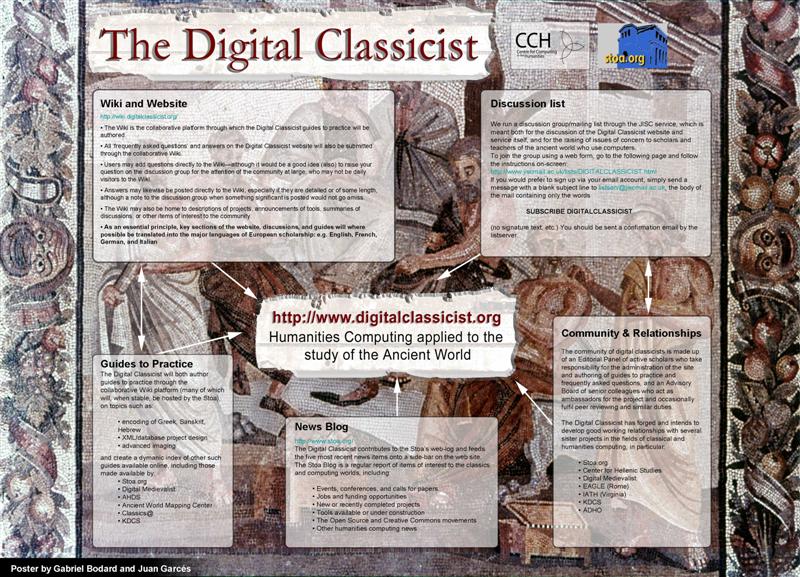|
EpiDoc
EpiDoc is an international community that produces guidelines and tools for encoding in TEI XML scholarly and educational editions of ancient documents, especially inscriptions and papyri. The EpiDoc Guidelines were originally proposed as a recommendation for Greek and Latin epigraphy in 2000 by scholars at the University of North Carolina at Chapel Hill: Tom Elliott, the former director of the Ancient World Mapping Center, with Hugh Cayless and Amy Hawkins. The guidelines have since matured considerably through extensive discussion on the community mailing list (Markup) and other discussion fora, at several conferences, and through the experience of various pilot projects. The first major epigraphic projects to adopt and pilot the EpiDoc recommendations were the Inscriptions of Aphrodisias and Vindolanda Tablets Online in 2002–4, and the guidelines reached a degree of stability for the first time in that period. EpiDoc has since been adopted as the native format for the Greek ... [...More Info...] [...Related Items...] OR: [Wikipedia] [Google] [Baidu] |
EpiDoc Logo
EpiDoc is an international community that produces guidelines and tools for encoding in TEI XML scholarly and educational editions of ancient documents, especially inscriptions and papyri. The EpiDoc Guidelines were originally proposed as a recommendation for Greek and Latin epigraphy in 2000 by scholars at the University of North Carolina at Chapel Hill: Tom Elliott, the former director of the Ancient World Mapping Center, with Hugh Cayless and Amy Hawkins. The guidelines have since matured considerably through extensive discussion on the community mailing list (Markup) and other discussion fora, at several conferences, and through the experience of various pilot projects. The first major epigraphic projects to adopt and pilot the EpiDoc recommendations were the Inscriptions of Aphrodisias and Vindolanda Tablets Online in 2002–4, and the guidelines reached a degree of stability for the first time in that period. EpiDoc has since been adopted as the native format for the Greek ... [...More Info...] [...Related Items...] OR: [Wikipedia] [Google] [Baidu] |
Inscriptions Of Aphrodisias
Inscriptions of Aphrodisias was a project funded by the Leverhulme Trust and the British Academy that aimed to publish the inscriptions of the Greek ancient site of Aphrodisias (modern day Turkey) online. Apart from aiming for a digital publication of the inscriptions, the experience from this publishing process was intended to be used for further development of the guidelines of the EpiDoc collaborative, on which the publication was based. History Initial efforts to form an international team of collaborators were already made in 2002, with a British Academy project led by Charlotte Roueché and Geoffrey B. Waywell. A first major result was the publication of 'Aphrodisias in Late Antiquity' ('ala2004') by Charlotte Roueché in 2004, which iavailable online Leverhulme's grant in 2004 also allowed the establishment of several workshops a year from May the same year. These workshops were held in the United States, the United Kingdom and mainland Europe to allow wide participation ... [...More Info...] [...Related Items...] OR: [Wikipedia] [Google] [Baidu] |
Leiden Conventions
The Leiden Conventions or Leiden system is an established set of rules, symbols, and brackets used to indicate the condition of an epigraphic or papyrological text in a modern edition. In previous centuries of classical scholarship, scholars who published texts from inscriptions, papyri, or manuscripts used divergent conventions to indicate the condition of the text and editorial corrections or restorations. The Leiden meeting was designed to help to redress this confusion. The earliest form of the conventions was agreed at a meeting of classical scholars at the University of Leiden in 1931 and published the following year. There are minor variations in the use of the conventions between epigraphy and papyrology (and even between Greek and Latin epigraphy). More recently, scholars have published improvements and adjustments to the system.See e.g. Dow (1969) and Krummrey–Panciera (1980). ''Cf.'' Robert (1954), 9–11, who seemingly rejects Leiden. Most important ''sigla'' Se ... [...More Info...] [...Related Items...] OR: [Wikipedia] [Google] [Baidu] |
ODD (Text Encoding Initiative)
The Text Encoding Initiative (TEI) is a text-centric community of practice in the academic field of digital humanities, operating continuously since the 1980s. The community currently runs a mailing list, meetings and conference series, and maintains the TEI technical standard, a journal, a wiki, a GitHub repository and a toolchain. TEI guidelines The ''TEI Guidelines'' collectively define a type of XML format, and are the defining output of the community of practice. The format differs from other well-known open formats for text (such as HTML and OpenDocument) in that it is primarily semantic rather than presentational; the semantics and interpretation of every tag and attribute are specified. There are some 500 different textual components and concepts (, , , , , etc.); each is grounded in one or more academic disciplines and examples are given. Technical details The standard is split into two parts, a discursive textual description with extended examples and discussion and ... [...More Info...] [...Related Items...] OR: [Wikipedia] [Google] [Baidu] |
Text Encoding Initiative
The Text Encoding Initiative (TEI) is a text-centric community of practice in the academic field of digital humanities, operating continuously since the 1980s. The community currently runs a mailing list, meetings and conference series, and maintains the TEI technical standard, a journal, a wiki, a GitHub repository and a toolchain. TEI guidelines The ''TEI Guidelines'' collectively define a type of XML format, and are the defining output of the community of practice. The format differs from other well-known open formats for text (such as HTML and OpenDocument) in that it is primarily semantic rather than presentational; the semantics and interpretation of every tag and attribute are specified. There are some 500 different textual components and concepts (, , , , , etc.); each is grounded in one or more academic disciplines and examples are given. Technical details The standard is split into two parts, a discursive textual description with extended examples and discussion a ... [...More Info...] [...Related Items...] OR: [Wikipedia] [Google] [Baidu] |
Epigraphy
Epigraphy () is the study of inscriptions, or epigraphs, as writing; it is the science of identifying graphemes, clarifying their meanings, classifying their uses according to dates and cultural contexts, and drawing conclusions about the writing and the writers. Specifically excluded from epigraphy are the historical significance of an epigraph as a document and the artistic value of a literature, literary composition. A person using the methods of epigraphy is called an ''epigrapher'' or ''epigraphist''. For example, the Behistun inscription is an official document of the Achaemenid Empire engraved on native rock at a location in Iran. Epigraphists are responsible for reconstructing, translating, and dating the trilingual inscription and finding any relevant circumstances. It is the work of historians, however, to determine and interpret the events recorded by the inscription as document. Often, epigraphy and history are competences practised by the same person. Epigraphy ... [...More Info...] [...Related Items...] OR: [Wikipedia] [Google] [Baidu] |
Papyrology
Papyrology is the study of manuscripts of ancient literature, correspondence, legal archives, etc., preserved on portable media from antiquity, the most common form of which is papyrus, the principal writing material in the ancient civilizations of Egypt, Greece, and Rome. Papyrology includes both the translation and interpretation of ancient documents in a variety of languages as well as the care and conservation of rare papyrus originals. Papyrology as a systematic discipline dates from the 1880s and 1890s, when large caches of well-preserved papyri were discovered by archaeologists in several locations in Egypt, such as Arsinoe (Faiyum) and Oxyrhynchus. Leading centres of papyrology include Oxford University, Heidelberg University, the Ägyptisches Museum und Papyrussamlung at the Staatliche Museen zu Berlin, Columbia University, the University of Michigan, Leiden University, the Österreichische Nationalbibliothek, University of California, Berkeley The University of C ... [...More Info...] [...Related Items...] OR: [Wikipedia] [Google] [Baidu] |
Epigraphers
Epigraphy () is the study of inscriptions, or epigraphs, as writing; it is the science of identifying graphemes, clarifying their meanings, classifying their uses according to dates and cultural contexts, and drawing conclusions about the writing and the writers. Specifically excluded from epigraphy are the historical significance of an epigraph as a document and the artistic value of a literature, literary composition. A person using the methods of epigraphy is called an ''epigrapher'' or ''epigraphist''. For example, the Behistun inscription is an official document of the Achaemenid Empire engraved on native rock at a location in Iran. Epigraphists are responsible for reconstructing, translating, and dating the trilingual inscription and finding any relevant circumstances. It is the work of historians, however, to determine and interpret the events recorded by the inscription as document. Often, epigraphy and history are competences practised by the same person. Epigraphy ... [...More Info...] [...Related Items...] OR: [Wikipedia] [Google] [Baidu] |
Vindolanda Tablets
The Vindolanda tablets were, at the time of their discovery, the oldest surviving handwritten documents in Britain (they have since been antedated by the Bloomberg tablets). They are a rich source of information about life on the northern frontier of Roman Britain. Written on fragments of thin, post-card sized wooden leaf-tablets with carbon-based ink, the tablets date to the 1st and 2nd centuries AD (roughly contemporary with Hadrian's Wall). Although similar records on papyrus were known from elsewhere in the Roman Empire, wooden tablets with ink text had not been recovered until 1973, when archaeologist Robin Birley, his attention being drawn by student excavator Keith Liddell, discovered some at the site of Vindolanda, a Roman fort in northern England. The documents record official military matters as well as personal messages to and from members of the garrison of Vindolanda, their families, and their slaves. Highlights of the tablets include an invitation to a birth ... [...More Info...] [...Related Items...] OR: [Wikipedia] [Google] [Baidu] |
Papyrology
Papyrology is the study of manuscripts of ancient literature, correspondence, legal archives, etc., preserved on portable media from antiquity, the most common form of which is papyrus, the principal writing material in the ancient civilizations of Egypt, Greece, and Rome. Papyrology includes both the translation and interpretation of ancient documents in a variety of languages as well as the care and conservation of rare papyrus originals. Papyrology as a systematic discipline dates from the 1880s and 1890s, when large caches of well-preserved papyri were discovered by archaeologists in several locations in Egypt, such as Arsinoe (Faiyum) and Oxyrhynchus. Leading centres of papyrology include Oxford University, Heidelberg University, the Ägyptisches Museum und Papyrussamlung at the Staatliche Museen zu Berlin, Columbia University, the University of Michigan, Leiden University, the Österreichische Nationalbibliothek, University of California, Berkeley The University of C ... [...More Info...] [...Related Items...] OR: [Wikipedia] [Google] [Baidu] |
Digital Classicist
The Digital Classicist is a community of those interested in the application of digital humanities to the field of classics and to ancient world studies more generally. The project claims the twin aims of bringing together scholars and students with an interest in computing and the ancient world, and disseminating advice and experience to the classics discipline at large. The Digital Classicist was founded in 2005 as a collaborative project based at King's College London and the University of Kentucky, with editors and advisors from the classics discipline at large. Activities of The Digital Classicist Membership Many notable Classicists and Digital Humanists are on the advisory board of the Digital Classicist, including Richard Beacham (of the King's Visualisation Lab), Alan Bowman (professor of Ancient History at University of Oxford), Gregory Crane (of the Perseus Project), Bernard Frischer (of the Virtual World Heritage Laboratory), Michael Fulford (professor of Archaeology ... [...More Info...] [...Related Items...] OR: [Wikipedia] [Google] [Baidu] |
Epigraphy
Epigraphy () is the study of inscriptions, or epigraphs, as writing; it is the science of identifying graphemes, clarifying their meanings, classifying their uses according to dates and cultural contexts, and drawing conclusions about the writing and the writers. Specifically excluded from epigraphy are the historical significance of an epigraph as a document and the artistic value of a literature, literary composition. A person using the methods of epigraphy is called an ''epigrapher'' or ''epigraphist''. For example, the Behistun inscription is an official document of the Achaemenid Empire engraved on native rock at a location in Iran. Epigraphists are responsible for reconstructing, translating, and dating the trilingual inscription and finding any relevant circumstances. It is the work of historians, however, to determine and interpret the events recorded by the inscription as document. Often, epigraphy and history are competences practised by the same person. Epigraphy ... [...More Info...] [...Related Items...] OR: [Wikipedia] [Google] [Baidu] |





